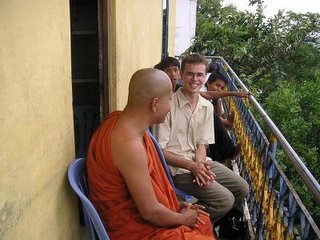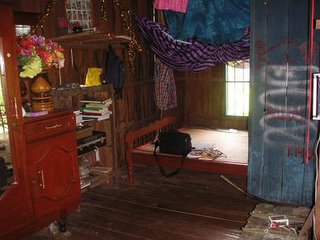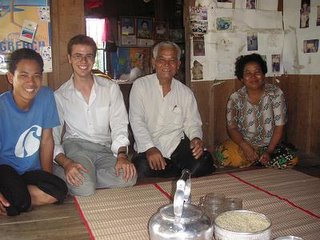I recently conducted an interview for Cambodian Living Arts (CLA) in the village where I am studying smot in Kompong Speu. The aim of the interview was to get an idea of how the CLA class has changed the lives of the young smot students in the village.Pheuan Srey Peu, 15, lives in Tropeang Po village in Kompong Speu Province, where she has been studying in CLA's smot (a form of vocal funeral music) class since January 2004. Currently a ninth-grade student at the local public school, Ms. Srey Peu had never had any musical training before the masters Prum Uth and Gaut Ran began to teach smot in a newly-founded CLA class almost two years ago.
Smot is a particulary difficult form of music for young Cambodians to learn because the melodies and vocal style are unlike any other form and the words of the songs use many Pali words and cryptic vocabulary that is often highly removed from everyday Khmer speech. Nevertheless, the form is deeply integral to Khmer culture, especially for Cambodian Buddhism, and when Srey Peu found out that the master musician Ieng Sithul would hold auditions for a smot class, she was immediately interested.
She had always loved traditional Khmer music, and was especially interested in singing. However, she had never had any opportunity to study these forms. In addition, she recalls that she liked going often to the local wat, offering food to monks, and listening to the elders of the village chant Buddhist scripture. Her only experience hearing smot, however, had been at the funerals she attended over the courser of her life, and before the smot class came to her village, she had not been interested in it.
Ms. Srey Peu has excelled in her studies of smot so far, and was quickly identified as one of the most promising students in the class, especially for her well-developed voice and amazing mental capacity to commit smot songs to memory. Even though she is still a student, she is frequently asks to perform smot songs at various functions at the local wats, much to the appreciation of the older members of the community.
In her words, "Before I began to study smot, I was interested in singing traditional Khmer songs, but I never I had the chance to study. So I only thought of myself as a normal, average person. After having studied smot, we have the feeling that we are special and extraordinary, because we are young and yet we know how to smot and we know about Buddhist chants." Srey Peu is known throughout the village and neighboring ones for her beautiful voice when she sings smot.
When she graduates from high school, Ms. Srey Peu says she is very interested in teaching smot to children, like the smot masters in the CLA class have done for her, because she wants the traditional smot songs of the Khmer people to not disappear and instead continue to be part of the rebirth of Khmer society.
Through CLA's smot class, Ms. Srey Peu has been able to discover and explore her talents a musician and smot singer, and thereby find direction to her life that she otherwise would not have had. She says that the class and her developing career in smot singing have given great joy and meaning in her life, and she now feels she has a chance to rise out of bleak future afforded by a life of farming in her village. Although she speaks truthfully that a good salary is probably the most important consideration for her future employment, she says that if a career solely based on teaching and performing smot would be a possibility for her, she would pursue this without hesitation.
Indeed, in the coming years such a career may be a possible one for her, but in truth, whatever career she ultimately pursues, smot singing and her passion for teaching it will be present, because in her own words, she says that "I don't want it to disappear, and hope that we will have it forever."


 They asked me to give a speech, though I admit I was at a loss at what to say.
They asked me to give a speech, though I admit I was at a loss at what to say. 















